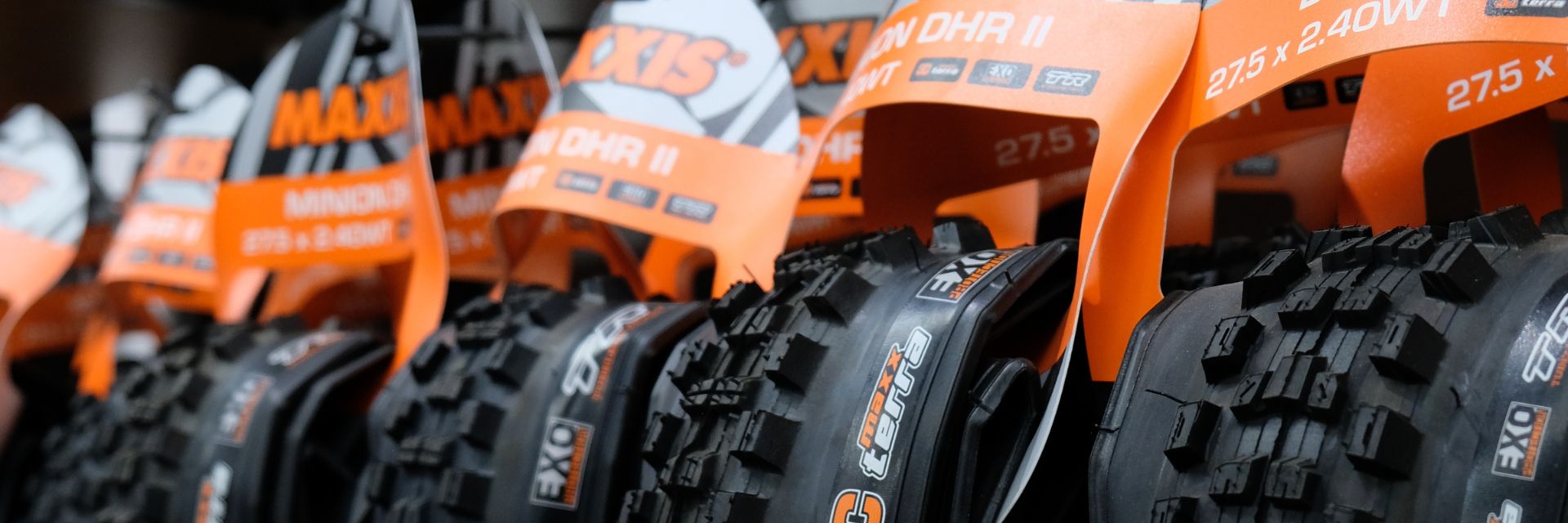
How To Choose MTB Tires: The Complete Guide
Selecting the right mountain bike tires has a huge impact on how your bike handles on the trails. With so many options to pick from, trying to find the right set can be a headache, so we’ve put together this comprehensive guide that breaks down the steps of how to choose mountain bike tires.
We’ll dive into important details such as tread pattern, tire width, and tubeless design to bring you up to speed with the latest MTB trends. So whether you’re replacing worn tires or trying something new, this mountain bike tire buying guide has got you covered.
Table of contents
Here's a basic summary of what the article covers. If you know exactly what part of the process you're interested in, you can click each section to jump the appropriate place on the page.
3. Decide if you're going tubeless
4. Pick a tread pattern (tire model)
6. Our favorite tires by riding style
8. FAQs
What to know before you start your search for a new MTB tire
To make your search for new rubber easier, confirm the size of the tires and wheels that are already on your bike. Also, think about the kind of trails you normally ride and what the riding surface looks like. Reflect on what you want your new tires to excel at or if you are hoping to avoid a past issue with your previous tires.
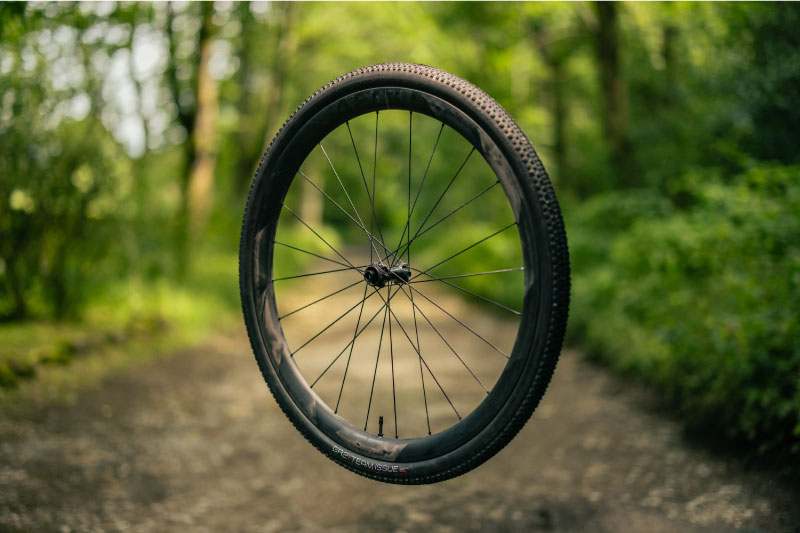
Step 1: Get the right wheel size
Mountain bike tires come in 29”, 27.5” or 26” sizes. If you’re unsure what wheel size you have, look along the sidewall of the existing tires to find the labeled size. Tire sizes are embossed or marked on the side of the tire with the diameter listed first followed by the tire width— for example, 29 x 2.4”. Be sure your new tire matches the right size of your wheel.
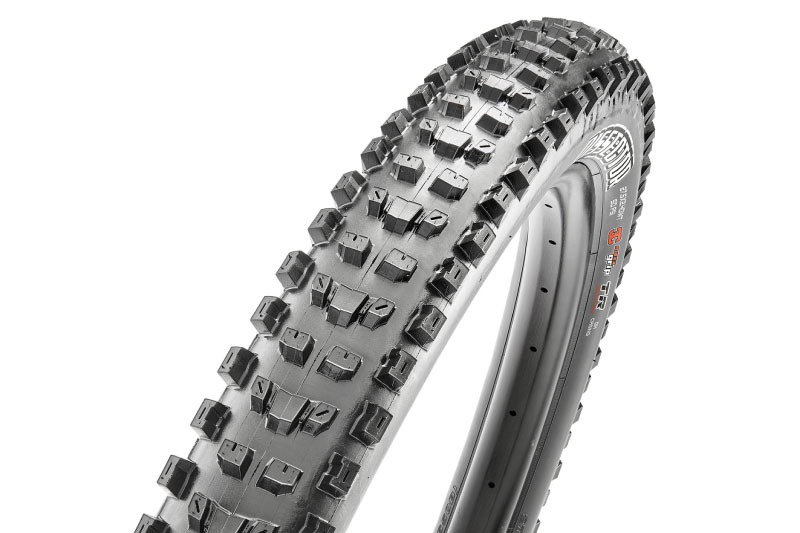
Step 2: Choose your tire width
Getting tire width right is key to getting the most out of your mountain bike. Bike frames and rims have a limited amount of tire clearance, so it’s important to check the maximum tire width your frame and rims will allow. Between the margins, you can select the mountain bike tire width that provides the right characteristics for where and how you ride.
Make sure you look up your bike’s maximum tire clearance
Take a look at the manufacturer’s specifications for the bike which are typically listed on their website. To get a rough idea, you can see what size your current tires are and how much space there is between the tires and frame. If your rear tire is already very close to the seat tube or chainstays, you may not have much room for wider rubber. Ask your local bike shop to help get a more accurate measurement if you can’t find your frame’s max tire clearance.
Check your rim’s recommended tire width
When getting new tires, it’s always a safe bet to go with the same width as your old ones. If you want to change the width by +/- 0.2” or more, you’ll want to confirm that your rim can accommodate the new size. Rims typically have the make and model written on them which you can look up to see how wide of a tire they’re designed for. The mechanics at your local bike shop can help you out with this if you can’t find that info.
Mountain bike tire size chart
| Tire Style | Tire Size |
|---|---|
| XC | 1.9" - 2.2" |
| Trail/All Mountain | 2.3" - 2.6" |
| Enduro/Downhill | 2.4" - 2.6" |
| Plus | 2.8" - 3.5" |
| Fat | > 3.5" |
Mountain bike tire sizes by style
Tire width varies across mountain bike disciplines, typically ranging from 1.9” all the way up to a whopping 5” on oversized fat tire bikes! Tire width affects factors like speed, weight, and traction that influence how a bike performs. Check out the most common tire sizes for MTB categories below.
XC mtb tire sizes
Cross-country tires usually measure between 1.9”-2.2” wide which is the narrowest among mountain bike tires. They’re designed to provide maximum speed on trails with lots of pedaling and less technical descents. The lightweight casing and low rolling resistance are geared toward those marginal gains while racing.
Trail/All mountain mtb tire sizes
Trail and all-mountain tire width generally falls between 2.3”-2.6”, giving riders plenty of choices. If you’re a casual trail rider or someone who wants a well balanced tire for all kinds of riding, trail tires in this range will work great.
Enduro and downhill mtb tire sizes
These heavy-duty tires measure around 2.4”-2.6” wide with durable casings and an aggressive tread pattern. The tire compound has to be more protective and a bit stiffer to withstand the higher speeds and bigger hits of technical downhill riding. That durability makes them heavier, making them less ideal for fast pedaling speed on lower angle terrain.
Plus mtb tire sizes
Also referred to as “mid-fat”, plus tires measure between 2.8”-3.5” wide to provide a larger contact patch and better traction and floatation on the trail. These tires are so big that their effective diameter is closer to the next wheel size up— for example, a 27.5x3.0” tire has a similar diameter to that of a 29x2.25”. If you’re not already running plus tires, be sure to check that your frame and rims can accept this width.
Fat bike tire sizes
These big tires get their name because of their behemoth size that’s anything 3.5” or larger. The tires’ large contact patch makes it easier to get grip in soft terrain such as sand, mud, and snow. The extra width also means larger air volume that can be run at lower pressures for more traction and floatation. Fat tire bikes have specific frame and rim designs, so you’re almost never going to be able to fit these on a normal MTB.
FAQ: Can I put bigger tires on my mountain bike?
Riders can run larger tires as long as the bike frame has sufficient tire clearance and compatible rim width. It’s not uncommon to change tires on your mountain bike for ones with a wider profile, but you’ll need to check with the specs of your frame and rims.
FAQ: Can I put gravel, hybrid, or road tires on my mountain bike?
If you’re trying to fit skinny tires on your MTB, the answer is almost always no. Mountain bike tires aren’t designed to be compatible with the narrow widths of most 700c size gravel, hybrid, and road tires. However, there are some 650b gravel and hybrid tires that have the same or similar widths as 27.5” MTB tires, and while they will certainly change the way your mountain bike rides, they can sometimes work without too much trouble.
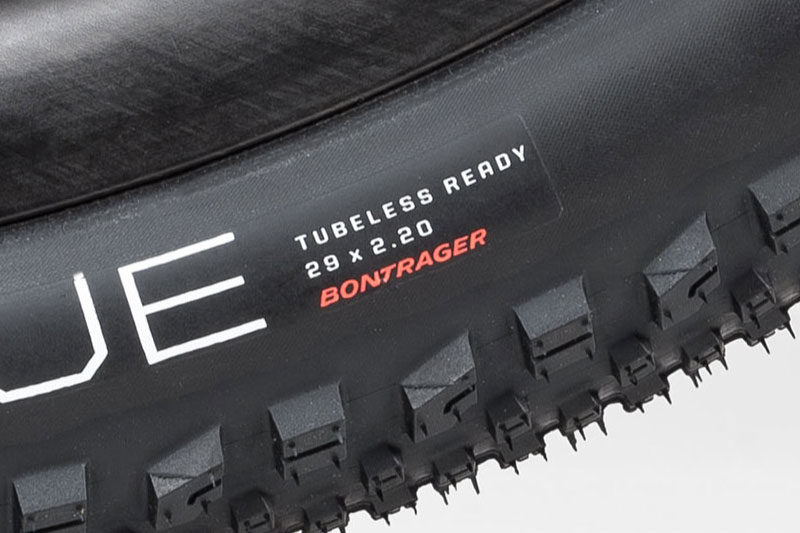
Step 3: Decide between tubeless tires or tires that use inner tubes
Mountain bikers have two options for tire types: tires that are meant to be pumped up with an inner tube and tubeless tires that use liquid sealant. For most trail riders, only tubeless tires are worth riding.
Are tubeless mountain bike tires better?
We say yes! Going tubeless means you’ll have fewer flats out on the trail which is a huge plus. The sealant automatically patches small punctures as you roll so you often won’t need to interrupt your ride just because you ran over something small and pointy. Tubeless tires also allow you to run lower tire pressure which makes for a more comfortable, grippier ride. Even with sealant inside, there is normally still some weight savings too.
Can any mountain bike tire be tubeless?
While you can definitely run an inner tube inside tubeless tires and rims, trying to turn non-tubeless tires and rims into a tubeless setup can be an arduous process that we don’t recommend. Save yourself some time and headaches and use tires and rims that are designed to be tubeless compatible.
Situations when you might choose tubes over tubeless
Tubeless tires are increasingly popular and are the best bet for most mountain bikers, but they may not be the right choice for every situation. The initial installation process can be a challenge without access to an air compressor or a floor pump at the very least, as it’s difficult for mini pumps to provide enough inflation force to seat tubeless tire beads quickly on the rim. Tubes are also a lot less messy.If you ride on light terrain or go touring far away from bike shops with tubeless supplies, traditional inner tubes can still be a solid choice.
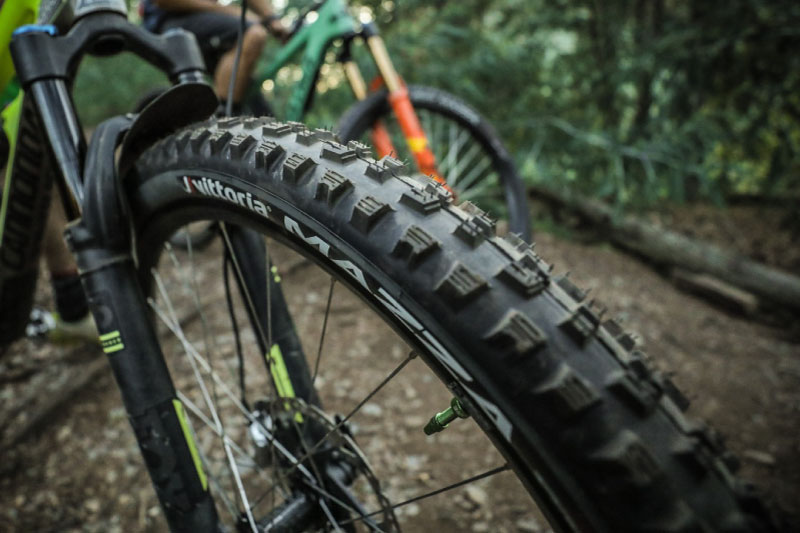
Step 4: Step 4: Pick a tread pattern (aka a tire model)
Besides tire width, tread pattern has the next largest impact on how a tire performs. To help you select the right tire model, we’ll describe the different tread patterns available and explain what to look for based on your preferred riding style.
Common tread patterns by riding style
Tread patterns are optimized for specific riding disciplines to maximum speed and grip. Riders will notice a difference in traction as well as cornering confidence and efficiency. To get the best mountain bike tire, choose a model with tread that’s designed for the terrain you’ll be riding.
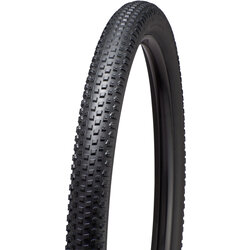
XC mtb tire tread
The fast-rolling, more tightly packed tread pattern features short to medium knobs to balance efficiency and grip on XC terrain.
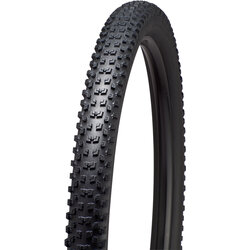
Trail/All Mountain mtb tire tread
These mid-sized tires are super versatile due to their moderate tread pattern that grips well in a variety of conditions. Tires in this style of riding can vary greatly in tread patterns as there are lots of different types of surfaces and riding styles to consider. But typically you’ll find the lugs are a bit larger and more spaced out than what you’d see with XC tires.
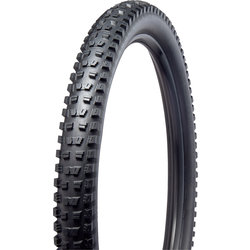
Enduro & downhill mtb tire tread
Enduro and downhill riders benefit from tires with big tread blocks for excellent traction on steep, technical terrain. You’ll typically see more space between the lugs as well as deep grooves between lugs help clear mud, too.
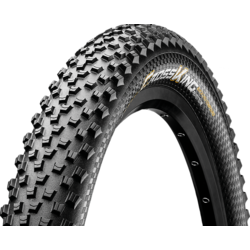
Plus mtb tire tread
These oversized tires often have the moderate tread pattern of XC or all-mountain tires even though they’re significantly wider for a larger contact patch and more float.
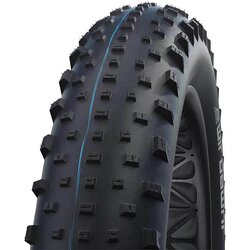
Fat bike tire tread
The tread pattern is typically moderate since the tires’ low PSI and increased surface area does most of the heavy lifting. Some fat bike tires that are designed more for ripping around groomed snow trails will have more aggressive tread than expedition focused tires that are better for floating over top of loose terrain like sand.
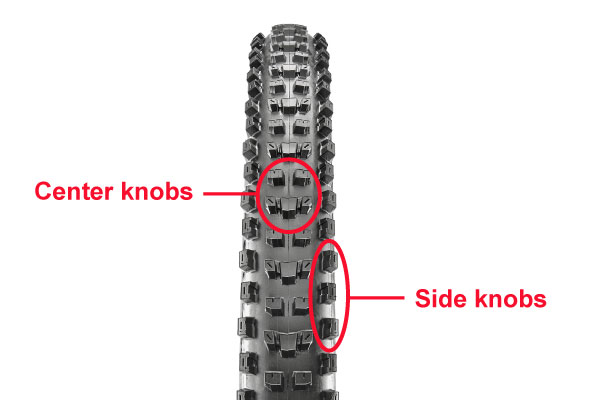
What does tire tread consist of?
Center knobs: the lugs in the middle of the tire that determine your bike grips the trail when you're pedaling and riding straight
Side knobs: the lugs on either side of the center that influence how your bike grips when you're cornering
Knob size: bigger knobs are better for traction on challenging terrain and smaller knobs roll faster on smoother trails
Knob spacing: tighter spacing decreases rolling resistance and is used on harder-packed surfaces, while wide knob spacing leaves enough room to dig into the trail and channel water and shed mud.
Knob design: the shape of the individual lugs enhances the tread pattern's efficiency on the trails it's designed for
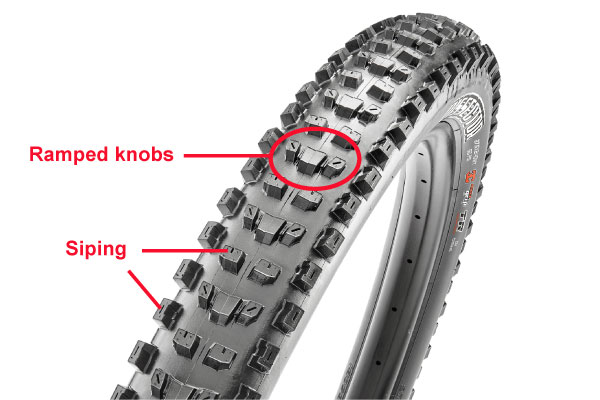
More on tread design:
Tapered knobs are wider at the base of the knob and are useful in muddy conditions since they penetrate the trail surface and easily shed debris.
Ramped knobs (as opposed to square knobs) have one sloped side that improves rolling speed under certain conditions.
“Siping” is small cuts that increase flex and multi-directional grip.
Winter tires have knobs with holes that can accommodate metal spikes for riding on snow or ice.
How tire tread affects your riding (how you ride)
Speed: You don’t have to be a racer to care about speed and efficiency. As a general rule, the smoother and tighter the tread pattern, the faster you can ride on hard pack surfaces. Tires with small, tightly packed knobs have a lower rolling resistance that’s great for XC racing or gravel riding.
Grip: Another critical part of tire choice is the traction that keeps you on the trail and riding in control. Tire grip comes from the interaction between the tread and trail surface. Each individual knob catches a piece of the trail and the raised edges of each lug allows for better traction. The types of trails you ride should determine how much grip you’re looking for.
Braking: Slowing down a mountain bike puts a lot of force into the tires, so the tread needs to be aggressive enough to push back against the trail. Braking suddenly with slick tires would lead to skidding down the mountain, but a knobby tread provides safe and predictable braking.
How tire tread is influenced by trail surface (where you ride)
The magic of tire tread is how it matches up to certain terrain, allowing riders to optimize their performance according to where they ride. Tire tread gives you clues to which specific trail surfaces it’s designed for.
Hard pack trail surfaces: Hardpack dirt or slick rock means high speeds and lighter tread patterns. Hard pack tires typically have a smoother center tread for low rolling resistance in a straight line and slightly chunkier tread along the sides for better control while cornering.
Soft trail surfaces: The appropriate tread pattern for softer trail surfaces is one with deeper and more widely-spaced knobs. The tire can dig into the soft ground and ample spacing helps shed any mud that would get stuck in between the lugs.
Loose trail surfaces: Tire tread for riding over loose rocks and roots is more aggressive and has taller side knobs. There is plenty of surface area on the big lugs to grab onto the unpredictable trail surface and propel the bike forward.
Muddy trail surfaces: There are tall, widely-spaced lugs that penetrate the sticky trail surface and easily shed mud. This setup provides solid traction and the deep grooves avoid debris build-up between the knobs.
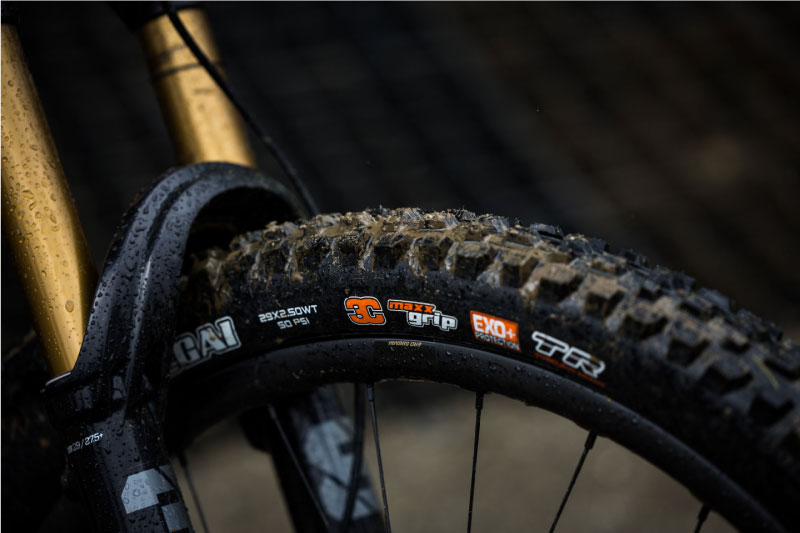
Step 5: Select your tire construction
The material and construction of a mountain bike tire are important indicators of a tire’s quality. Premium tires made from performance focused compounds are more supple, durable, and provide a more responsive ride feel on the trail. The three factors to pay attention to are tire casing, the bead type, and puncture protection.
Tire casing
Casing is the main body of the tire that gives it its structure. It’s made from layers of tightly woven threads to create a kind of cloth which is then covered in rubber. The standard measurement of casing quality is TPI—threads per inch— and indicates the number of threads contained in one inch of the tire casing. The higher the TPI, the more responsive and high-quality the tire.
Tire bead
The bead is the edge of the tire that hooks onto the rim. The two types of tire beads are wire and folding beads. A wire bead is a thin steel wire running along the inside edge of the tire. They are typically heavier and less expensive than folding bead tires. Folding beads are made from lightweight aramid (aka Kevlar) and are found on performance-oriented tires. Foldable tires can be collapsed down for easy storage whereas less flexible wire bead tires are always expanded to their full size.
Puncture protection
Some tires come with a built-in layer of puncture protection. This additional layer of puncture-resistant polymer is more durable than the surrounding rubber compound and designed to break debris like thorns or burrs that get lodged into the tire. Other tires include an extra layer that’s thick enough to prevent unwanted spiky items from getting through.
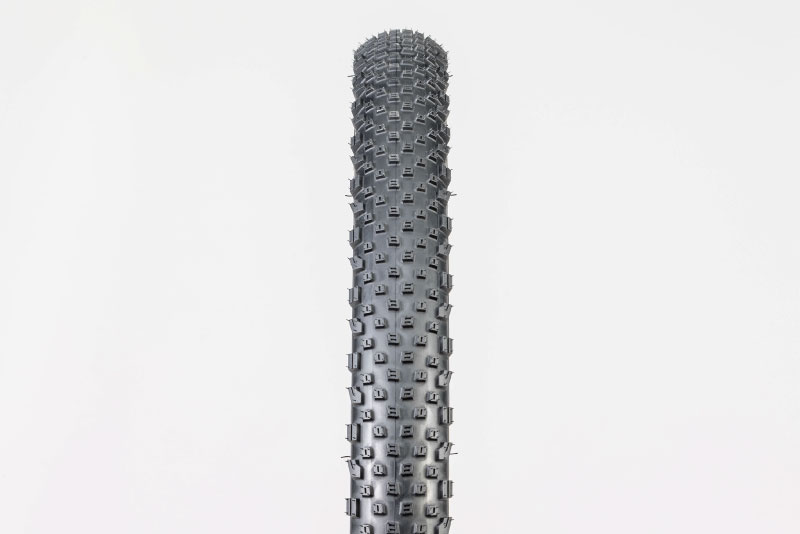
Recap of how to choose a mountain bike tire
Step 1: Make sure you know your wheel size
Step 2: Find the ideal tire width for your style of riding (make sure it'll fit!)
Step 3: Decide if you're going tubeless (almost all MTBers should)
Step 4: Pick a tread pattern (aka tire model) that matches your terrain and style
Step 5: Select your tire construction based on the ride qualities you're looking for
Best MTB tire brands
Maxxis and Continental are our favorite mountain bike tire brands. They have plenty of options for all kinds of riding styles and our customers love them. If you're after top performance you can't go wrong with them.
MTB tire FAQs
How do I know if I need new tires for my mountain bike?
It’s time for new mountain bike tires when there are signs of heavy wear or damage to the rubber. Tires become brittle over time and can start to crack and dry out, especially along the sidewall.
Other indications of wear are worn out tread, knobs that are coming off, or a “balding” tire that doesn’t grip as well as it used to. If there is a large puncture or rip in the tire, you should replace the tire to prevent a blowout later on.
How much do mountain bike tires cost?
Mountain bike tires can cost anywhere between $30 to well above $100 per tire for premium race rubber. To achieve the right balance of price and performance, tires around the $50-$70 mark are typically a great value for most riders.
How long do mountain bike tires last?
How long your tires last really depends on how hard and how often you ride. Some riders can keep the same tires for a couple seasons or more, while others need to freshen things up after one season. For example, aggressive riding over sharp rocks or abrasive surfaces will wear down the rubber faster.
How do I measure my mountain bike tire size?
Tire size is always marked somewhere along the sidewall of the tire. Look for a labeled or embossed measurement that lists the tire diameter and width in inches. It’ll look something like this: 29 x 2.20”.
Are mountain bike tires directional?
Yes, most MTB tires are designed to roll in a specific direction to optimize grip and braking performance. Sometimes you can intuit the intended direction based on the tread pattern, but the tire sidewall should have an arrow marking the direction of rotation.
Should I use a mountain bike tire insert?
Mountain bike tire inserts are made from durable foam and help prevent rim damage in the case of flats or big impacts, but they’re not for everyone. The extra weight and maintenance can be deal breakers for some whereas aggressive riders love the added wheel protection.
How much should I inflate my mountain bike tires?
While each tire comes with a recommended PSI range to stay within, where you should fall inside that range will depend on a few factors like tire size, rider weight, riding style, and terrain. It's important to know it's not an exact science, but here's how you can start off.
Start with a PSI that's in the middle of the recommended pressure range printed on the tire. If you want more cushion and grip you can go a little lower. If you want a bit more speed you can go up a bit. See how the tires feel and ride and adjust accordingly.


